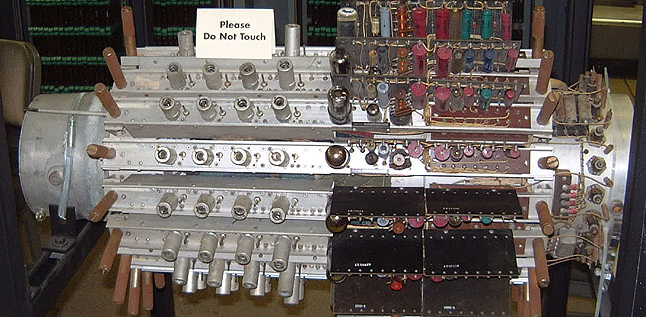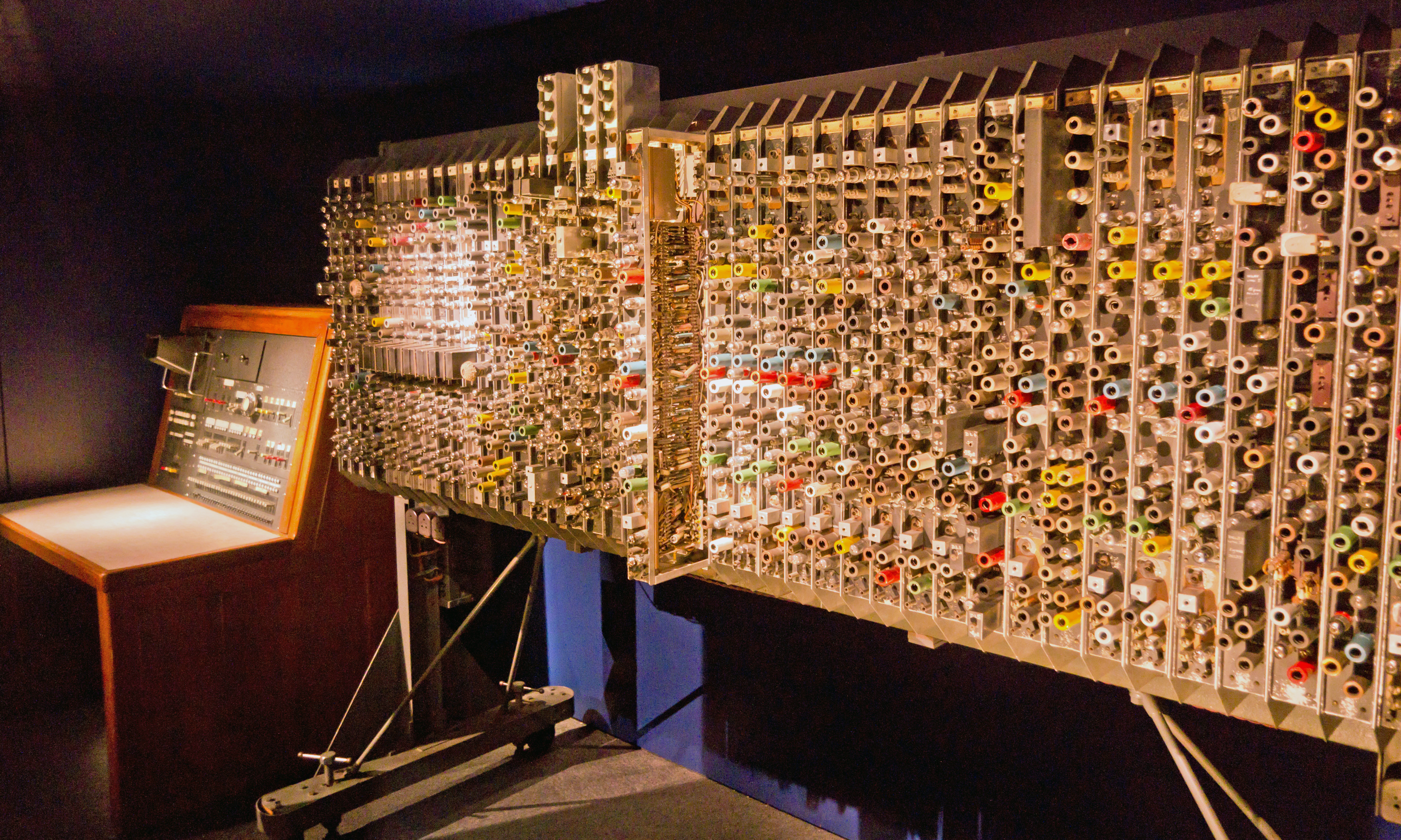|
Optimum Programming
In the history of computing, optimum programming, or optimum coding is the practice of arranging a computer program's instructions in memory so as to minimize the time the machine spends waiting for instructions. It is of historical interest mainly due to the design of many early digital computers. Most early computers used some form of serial memory, primarily delay-line memory or magnetic drums. Unlike the random-access memory of modern computers, words in serial memory are made available one at a time; the time required to access a particular word depends on the "distance" between it and the word currently being read. If a given delay line held ''n'' words, the average time to read a word would be ''n''/2 word times. Without optimum coding, such a machine would spend most of its time idly waiting for instructions and data. To circumvent this problem, many machines, particularly Alan Turing's ACE (computer), ACE and its descendants, included a field specifying the address of the n ... [...More Info...] [...Related Items...] OR: [Wikipedia] [Google] [Baidu] [Amazon] |
Delay-line Memory
Delay-line memory is a form of computer memory, mostly obsolete, that was used on some of the earliest Digital data, digital computers, and is reappearing in the form of #Optical_delay_lines, optical delay lines. Like many modern forms of electronic computer memory, delay-line memory was a memory refresh, refreshable memory, but as opposed to modern random-access memory, delay-line memory was Sequential access, sequential-access. Analog delay line technology had been used since the 1920s to delay the propagation of analog signals. When a delay line is used as a memory device, an amplifier and a pulse shaping, pulse shaper are connected between the output of the delay line and the input. These devices recirculate the signals from the output back into the input, creating a loop that maintains the signal as long as power is applied. The shaper ensures the pulses remain well-formed, removing any degradation due to losses in the medium. The memory capacity equals the time to transmit ... [...More Info...] [...Related Items...] OR: [Wikipedia] [Google] [Baidu] [Amazon] |
Magnetic Drum
Drum memory was a magnetic data storage device invented by Gustav Tauschek in 1932 in Austria. Drums were widely used in the 1950s and into the 1960s as computer memory. Many early computers, called drum computers or drum machines, used drum memory as the main working memory of the computer. Some drums were also used as secondary storage as for example various IBM drum storage drives and the UNIVAC FASTRAND series of drums. Drums were displaced as primary computer memory by magnetic core memory, which offered a better balance of size, speed, cost, reliability and potential for further improvements. Drums were then replaced by hard disk drives for secondary storage, which were both less expensive and offered denser storage. The manufacturing of drums ceased in the 1970s. Technical design A drum memory or drum storage unit contained a large metal cylinder, coated on the outside surface with a ferromagnetic recording material. It could be considered the precursor to the ... [...More Info...] [...Related Items...] OR: [Wikipedia] [Google] [Baidu] [Amazon] |
Random-access Memory
Random-access memory (RAM; ) is a form of Computer memory, electronic computer memory that can be read and changed in any order, typically used to store working Data (computing), data and machine code. A random-access memory device allows data items to be read (computer), read or written in almost the same amount of time irrespective of the physical location of data inside the memory, in contrast with other direct-access data storage media (such as hard disks and Magnetic tape data storage, magnetic tape), where the time required to read and write data items varies significantly depending on their physical locations on the recording medium, due to mechanical limitations such as media rotation speeds and arm movement. In today's technology, random-access memory takes the form of integrated circuit (IC) chips with MOSFET, MOS (metal–oxide–semiconductor) Memory cell (computing), memory cells. RAM is normally associated with Volatile memory, volatile types of memory where s ... [...More Info...] [...Related Items...] OR: [Wikipedia] [Google] [Baidu] [Amazon] |
Alan Turing
Alan Mathison Turing (; 23 June 1912 – 7 June 1954) was an English mathematician, computer scientist, logician, cryptanalyst, philosopher and theoretical biologist. He was highly influential in the development of theoretical computer science, providing a formalisation of the concepts of algorithm and computation with the Turing machine, which can be considered a model of a general-purpose computer. Turing is widely considered to be the father of theoretical computer science. Born in London, Turing was raised in southern England. He graduated from University of Cambridge, King's College, Cambridge, and in 1938, earned a doctorate degree from Princeton University. During World War II, Turing worked for the Government Code and Cypher School at Bletchley Park, Britain's codebreaking centre that produced Ultra (cryptography), Ultra intelligence. He led Hut 8, the section responsible for German naval cryptanalysis. Turing devised techniques for speeding the breaking of Germ ... [...More Info...] [...Related Items...] OR: [Wikipedia] [Google] [Baidu] [Amazon] |
ACE (computer)
The Automatic Computing Engine (ACE) was a British early electronic serial stored-program computer design by Alan Turing. Turing completed the ambitious design in late 1945, having had experience in the years prior with the secret Colossus computer at Bletchley Park. The ACE was not built, but a smaller version, the Pilot ACE, was constructed at the National Physical Laboratory and became operational in 1950. A larger implementation of the ACE design was the MOSAIC computer which became operational in 1955. ACE also led to the Bendix G-15 and other computers. Background The project was managed by John R. Womersley, superintendent of the Mathematics Division of the National Physical Laboratory (NPL). The use of the word ''Engine'' was in homage to Charles Babbage and his Difference Engine and Analytical Engine. Turing's technical design ''Proposed Electronic Calculator'' was the product of his theoretical work in 1936 " On Computable Numbers" (and ) and his wartime exper ... [...More Info...] [...Related Items...] OR: [Wikipedia] [Google] [Baidu] [Amazon] |
IBM 650
The IBM 650 Magnetic Drum Data-Processing Machine is an early digital computer produced by IBM in the mid-1950s. It was the first mass-produced computer in the world. Almost 2,000 systems were produced, the last in 1962, and it was the first computer to make a meaningful profit. The first one was installed in late 1954 and the IBM 650 was the most popular computer of the 1950s. The 650 was offered to business, scientific and engineering users as a slower and less expensive alternative to the IBM 701 and IBM 702 computers, which were for scientific and business purposes respectively. It was also marketed to users of punched card machines who were upgrading from calculating punches, such as the IBM 604, to computers. Because of its relatively low cost and ease of programming, the 650 was used to pioneer a wide variety of applications, from modeling submarine crew performance to teaching high school and college students computer programming. The IBM 650 became highly popular ... [...More Info...] [...Related Items...] OR: [Wikipedia] [Google] [Baidu] [Amazon] |
Bendix G-15
The Bendix G-15 is a computer introduced in 1956 by the Bendix Corporation, Computer Division, Los Angeles, California. It is about and weighs about . The G-15 has a drum memory of 2,160 29-bit words, along with 20 words used for special purposes and rapid-access storage. The base system, without peripherals, cost $49,500. A working model cost around $60,000 (). It could also be rented for $1,485 per month. It was meant for scientific and industrial markets. The series was gradually discontinued when Control Data Corporation took over the Bendix computer division in 1963. The chief designer of the G-15 was Harry Huskey, who had worked with Alan Turing on the Automatic Computing Engine (ACE) in the United Kingdom and on the Standards Western Automatic Computer (SWAC) in the 1950s. He made most of the design while working as a professor at University of California, Berkeley (where his graduate students included Niklaus Wirth), and other universities. David C. Evans was one of the ... [...More Info...] [...Related Items...] OR: [Wikipedia] [Google] [Baidu] [Amazon] |
Mel Kaye
The Story of Mel is an archetypical piece of computer programming folklore. Its subject, Melvin Kaye, is an exemplary "Real Programmer" whose subtle techniques fascinate his colleagues. Story Ed Nather's ''The Story of Mel'' details the extraordinary programming prowess of a former colleague of his, "Mel", at Royal McBee Computer Corporation. Although originally written in prose, Nather's story was modified by someone into a "free verse" form which has become widespread. Little is known about Mel Kaye, beyond the fact that he was credited with doing the "bulk of the programming" on the 1959 ACT-1 compiler for the Royal McBee LGP-30 computer. In Nather's story, Kaye is portrayed as being prone to avoiding optimizing assemblers in favor of crafting code to take advantage of hardware quirks, for example taking advantage of the rotation of the LGP-30's drum memory to avoid writing delay loops into the code. The story, as written by Nather, involved Kaye's work on rewriting a bla ... [...More Info...] [...Related Items...] OR: [Wikipedia] [Google] [Baidu] [Amazon] |
The Story Of Mel
The Story of Mel is an archetypical piece of computer programming folklore. Its subject, Melvin Kaye, is an exemplary " Real Programmer" whose subtle techniques fascinate his colleagues. Story Ed Nather's ''The Story of Mel'' details the extraordinary programming prowess of a former colleague of his, "Mel", at Royal McBee Computer Corporation. Although originally written in prose, Nather's story was modified by someone into a "free verse" form which has become widespread. Little is known about Mel Kaye, beyond the fact that he was credited with doing the "bulk of the programming" on the 1959 ACT-1 compiler for the Royal McBee LGP-30 computer. In Nather's story, Kaye is portrayed as being prone to avoiding optimizing assemblers in favor of crafting code to take advantage of hardware quirks, for example taking advantage of the rotation of the LGP-30's drum memory to avoid writing delay loops into the code. The story, as written by Nather, involved Kaye's work on rewriting a bl ... [...More Info...] [...Related Items...] OR: [Wikipedia] [Google] [Baidu] [Amazon] |





